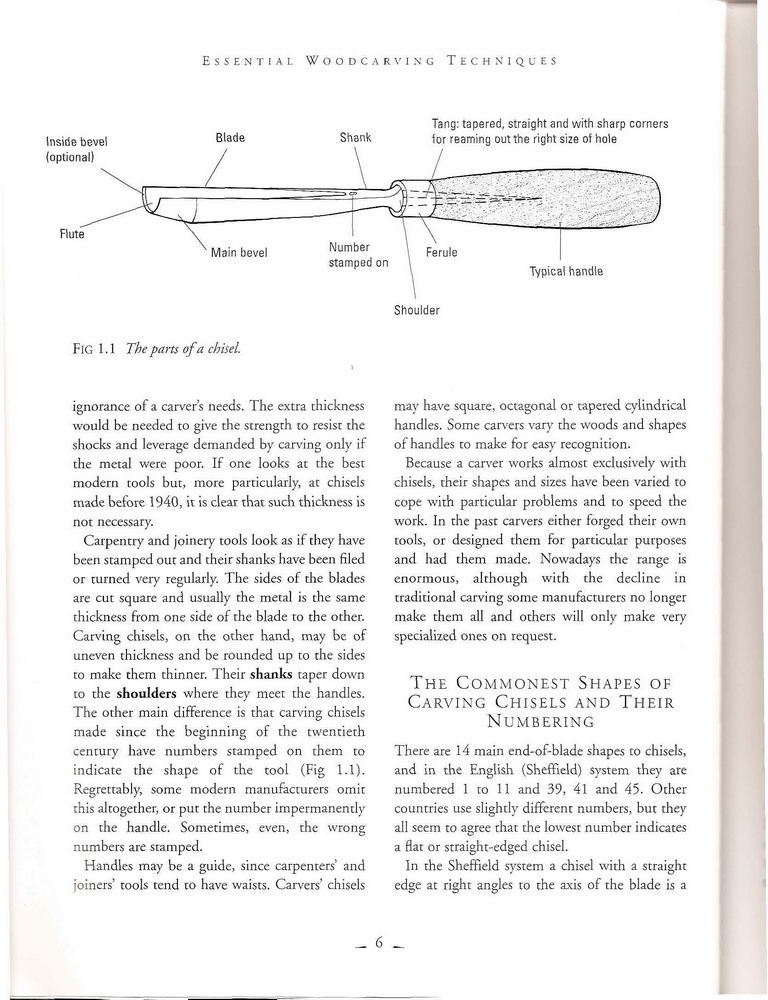essentÊrving°06

Essential W o o d c a r ving Techniques
Inside bevel
Blade
Shank
Tang: tapered, straight and with sharp corners for reaming out the right size of hole

FlG 1.1 The parts ofa chiseL
ignorance of a carvcrs needs. The cxtra thickness would bc needed to give the strength to resist thc shocks and lcverage demanded by carving only if the metal wcrc poor. If one looks at the best modern tools but, morÄ™ particularly, ac chisels madÄ™ before 1940, it is elear that such thickness is not nccessary.
Carpentry and joinery tools look as if they have been stamped out and their shanks have been filed or turned very regularly. The sides of the blades are cut squarc and usually the metal is the same thickness from one sidc of the blade to the other. Carving chisels, on the other hand, may bc of uneven thickness and be rounded up to thc sides to make them thinner. Their shanks taper down to the shoulders where they meet the handles. The other main difFerence is that carving chisels madę sińce the beginning of the twentieth century have numbers stamped on them to indicate the shape of the tool (Fig 1.1). Regrettably, some modern manufacturers omit this altogether, or pur the number impermanently on the handle. Sometimes, even, the wrong numbers are stamped.
Handles may be a guide, sińce carpenters’ and joiners tools tend to have waists. Carvers’ chisels may have square, octagonal or tapered cylindrical handles. Some carvcrs vary thc woods and shapes of handles to make for easy recognition.
Because a canrer works almost exclusively with chisels, their shapes and sizes have been varied to cope with particular problems and to speed the work. In the past carvers cither forged their own tools, or designed them for particular purposes and had them madÄ™. Nowadays the rangÄ™ is enormous, although with the decline in traditional carving some manufacturers no longer make them all and others will only make very specialized ones on request.
The Commonest Shapes of Carving Chisels and Their Numbering
There are 14 main end-of-bladc shapes to chisels, and in the English (Sheffield) system the)' arc numbered 1 to 11 and 39, 41 and 45. Other countries use slightly different numbers, but they all seem to agree that the lowest number indicates a flat or straight-edged chisel.
In the Sheffield system a chisel with a straight edge at right angles to the axis of the blade is a
Wyszukiwarka
Podobne podstrony:
essent?rving?10 Essentiai. Woodcarying Techniques Makes of Tool Maker/brand Country Edge-
essent?rving?14 pp Essential Woodcarvixg Techniques W Fig 1.17 Ttoo grounders. Very narrow old Engli
essent?rving?28 Essential Woodcarving Techniques Phloem or bast Bark Wood or xylem Roots anchor the
essent?rving?38 Essential W o o d c a R VIN g Techniques Fic; 2.16 Obeche with pinhole borer damage.
essent?rving?56 Essential Woodcarvixc Techniques Critical factors in cutting mouldings are the sizes
essent?rving?84 Essential Woodcarving Techniques Fig 7.7 This is how a piece of card would look if f
essent?rving?98 Essential Woodcarving Techniques Fig 9.1 Various lines. The one on the left Incks in
essent?rving?14 ESSENTIAL WOODCARNING TECHNIQUES 1 Base flattened before beginning carving. downward
essent?rving?42 Essential W o o d c a r vixc TechniqcesThe Composition Once rhe subjccr and its main
essent?rving?48 Essential W o o d c aR v
essent?rving?52 Essential Woodcarying Techniques Fig 14.3 Mov mg water. Fig 14.4 Drawings devełoping
Polish An Essential Grammar cikktoLOOK INSIDE! tMftnłia) Gram marPolish An Essemial GrammarDana Biel
essent?rving?70 Essential Woodcaryinc Techntiques Fig 5.11 The top surface of the leaffinished, with
essent?rving?92 Essentiai. Voodcarving T e c h n i q u f. s che ground then began crcating the relat
essent?rving?07 Fig 9.27 The handles of the tap were broken and dowelledfor strength. The Finish Sin
essent?rving?35 Fic 12.17 NotÄ™ the fullness of the brom and tbe eyebalis and the slope np from cheek
essent?rving?84 Making Kumihimo: Japancse Interbccd Braids Rodrtek Owen Crossing Cacti and Other Su
^IMVER3TVBelarusian National Technical Uniyersity ABOH • Ri.SF.VRni • STUDENT* • IEACBDS .AND SUIT •
więcej podobnych podstron